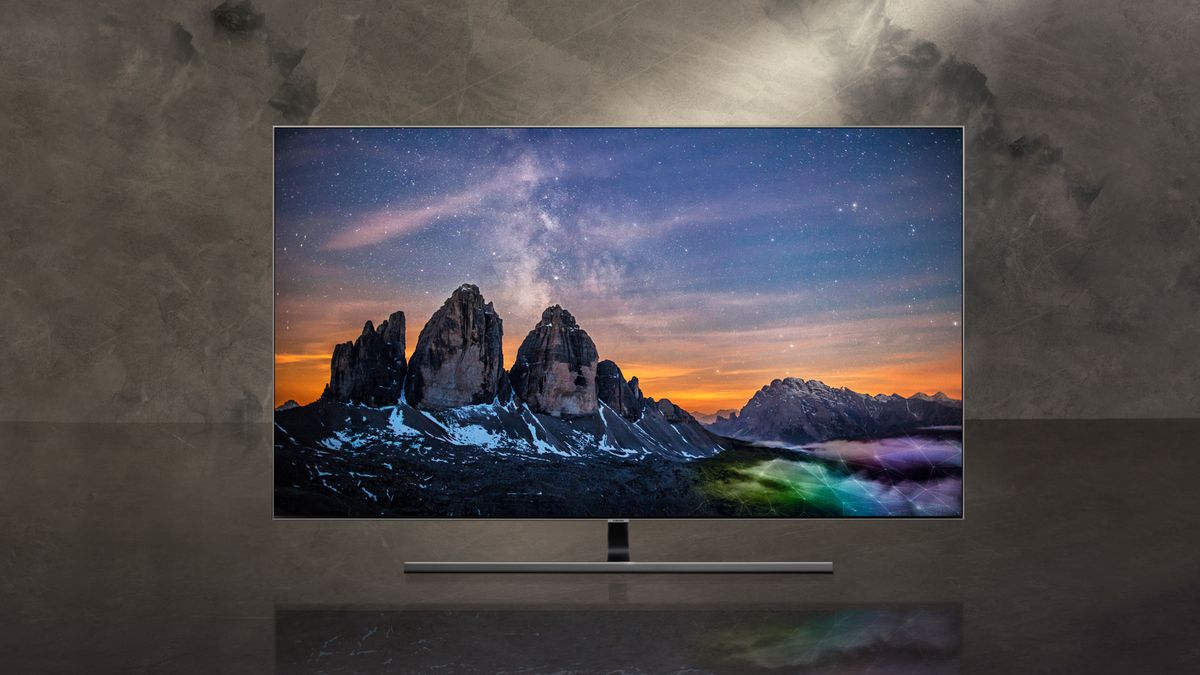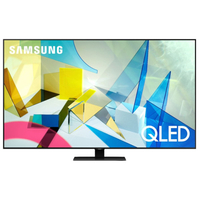TechRadar Verdict
Offering a superior 4K UHD picture performance, with excellent black levels and rich colour, Samsung’s mid-range QLED is a tempting alternative to the brand’s more expensive range-topping screens.
Pros
- +
Consistent black levels
- +
Direct Full Array backlight
- +
Excellent image processor
Cons
- -
No Freeview Play
- -
No Dolby Vision
Why you can trust TechRadar
The Samsung Q80R is potentially the breakout hit in the Samsung 2019 TV range. It may be third in line for the throne, after the inimitable Samsung Q90R and Samsung Q85R, but given that those two are virtually the same beast anyway (give or take nearly 400 backlight zones), the Q80R could be the QLED most buyers settle on.
Certainly it’s enviably well equipped, with a direct full array backlight, enhanced antireflection and contrast technologies, and a smart TV platform with some novel functionality. When it comes to bang for the buck, it beats like Lars Ulrich.
The only caveats are price, which is invariably on the steep side, and a certain elephant in the room named Dolby Vision...
What about Amazon Prime Day and Black Friday?
If you need a cheap QLED TV from Samsung, Amazon Prime Day on 13-14 October could be a great time to buy – and now that the Q80R is a little older, it could see some hefty discounts. If you need a little more time to choose your next TV, Black Friday is coming up on November 27, and we'll be here to bring you the best Black Friday TV deals we can find.
Samsung Q80R price and release date
In the UK, the Q80R is currently available in 55- and 65-inch sizes, called the QE55Q80R and the QE65Q80R, respectively, that will run you between £1,999 and £2,499, depending on which screen size you choose.
In the US, you'll be able to find both the 55-inch QN55Q80R and 65-inch QN65Q80R that will run you $1,999 and $2,799, respectively, but in addition there’s also the choice of the 75-inch QN75Q80R and 82-inch QN82Q80R that cost an eye-watering $3,999 and $5,299 apiece.
In Australia buyers can pick from 65-, 75- and 82-inch models - the QA55Q80R, QA65Q80R and QA75Q80R - that go for AU$3,899, AU$5,299 and AU$7,699.
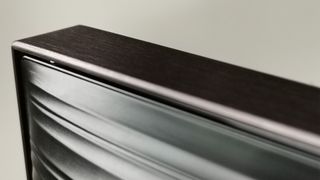
Design
Like the rest of Samsung’s 2019 QLED fleet, with the exception of the Samsung Q60R, the Q80R uses FALD (Full Array Local Dimming) backlight technology, for more precise HDR and greater contrast. This means it’s physically chunkier than edge-lit rivals. Not that we mind the heft.
Build quality is a tad less refined than its step-up stablemates, but its dress sense is still entirely respectable, with textured plastic back and tidy T-stand.
The FALD backlight translates to a panel depth of 62mm, so it lacks the sexy slimness of OLED, and it’s hefty too at 25.2kg. There's no separate One Connect Box with the Q80R, which would've allowed you to keep all the cables in one spot, which means cables will need to be routed right up into the TV. This is a bit of a hassle, but we didn't find it to be too much of a deal-breaker. Speaking of ports, there's a standard quartet of HDMI v2.0 inputs, two USB ports, Ethernet LAN, digital optical audio out, plus dual satellite and terrestrial tuner inputs. Wi-Fi is dual-band.
The set ships with a pair of remote controls, a standard IR zapper, and a smaller, less buttony-Bluetooth wand. Call us Luddites, but we naturally gravitate toward the IR pointer, even though the Bluetooth remote feels so much nicer in the hand.
Design TL;DR: The use of a Full Array backlight means this set was never going to be wafer thin, but the slim bezel and neat T-stand ensure it looks smart enough and connectivity ticks all the right boxes.
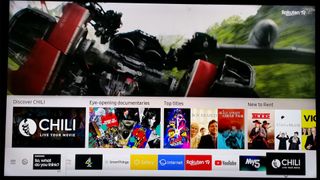
Smart TV (Tizen)
Samsung’s Tizen platform doesn’t get too much love compared to LG's WebOS, but here it’s well designed and intuitive to use. The two-tier layout is neat and tidy, and doesn't dominate screen real estate. One customisable bar offers access to all the usual streaming apps, while the other features Samsung TV Plus curated content. It’s here that you can rent movies from Rakuten TV, in both UHD and HD.
There’s no Freeview Play tuner on the UK edition of the set, so that means no rollback 7-day program guide to find the programs you've missed. However all the key catch-up TV channels are supported, along with Netflix, Amazon Prime Video and YouTube. There’s also, cue table drum roll, an Apple TV app.
Currently exclusive to Samsung, this allows Apple fans to rent and buy movies and TV shows from the Apple store, and stream from Apple’s TV channel bouquet. Admittedly this only includes the Smithsonian Channel and Starz Play at the moment, but it’ll also end up as the home of Apple’s new streaming TV service, which could make the app a must-have.
Of course there’s an irony here. The Apple movie store remains one of the best sources of Dolby Vision content. But that won't help you on this set...
Other smart niceties include Samsung’s Ambient mode, allowing your QLED to blend into garish wallpaper using the Background function, or double as a fancy clock when in standby; a Smart Things app which offers control of compatible devices via the TV, Photo Gallery and web browser.
There’s also voice control, using Samsung’s Bixby AI, and compatibility with Apple Airplay 2.
Smart TV TL;DR: With all the streaming apps you actually care about (plus a few you don’t) and some innovative smart functionality, Samsung’s Tizen platform excels when it comes to everyday usability.
- What is the best smart TV platform?
HD/SDR Performance
SDR picture modes comprise Standard, Dynamic, Natural and Movie, though our recommended options are Standard and Natural, the latter distinguished by a more contrasty approach that tends to crush some black level detail.
An Intelligent Mode, with adaptive brightness and adaptive sound, can be left to manage screen settings and insular an optimum performance without having to delve into menus. For this review, local dimming was left on Standard and Contrast Enhancer Low.
Samsung’s Image interpolation is powerful, but if you have an aversion to the dreaded ‘soap opera’ effect, you might want to tread carefully.The Auto Motion Plus settings can be manually configured, via adjustable blur and judder reduction, or simply left on Auto.
Our tip? For sports and studio content, the Auto setting is fine. It’s not particularly cinematic though. For a compromise that controls judder without looking overly processed, keep blur reduction on 0 and judder reduction around 3-4. There's also an LED clear motion option, however this black frame insertion process adversely darkens the image.
Samsung’s Ultra Viewing Angle technology trickles down from the models above, and does an excellent job of maintaining colour and contrast when viewed from the side. In the average living room, this is certain to be appreciated when it comes times to have friends over to watch the big match.
The set proves a good option for gamers, provided you master Samsung’s convoluted Game settings. We measured input lag at a paltry 13.7ms, but to achieve this delicious low figure you’ll need to ensure that Game mode is on, but Game Motion Plus is switched off.
HD/SDR Performance TL;DR: The Q80R has a top-notch HD performance. This pleasingly bright panel offers a good level of colour pop and contrast with Standard Dynamic Range (SDR) content.

4K/HDR Performance
As we’ve seen on the Q90R and Q85R, this QLED delivers a premium HDR performance. Reflecting its official designation of HDR 1500, by Samsung, we measured its peak brightness performance at an impressive 1200 cd/m (aka nits), using a 10 per cent HDR window.
This is more than bright enough to provide a sparkle with real world HDR content, and we found this a very rewarding HDR screen to watch.
Support covers vanilla HDR10, plus broadcast friendly HLG and dynamic metadata enabled HDR10+, which is widely used by Amazon Prime Video, and finding its way onto Blu-ray. Significantly though, there’s no compatibility with Dolby Vision.
Samsung’s stubborn refusal to back that particular Dolby horse is a frustration, not least because the relatively lower brightness of the Q80R would benefit from Dolby Vision's superior dynamic HDR handling.
On a lighter note, the set’s fine detail performance is first class. Adding to the sheer snap of the image is extremely good screen linearity and consistent black level performance, courtesy of the VA panel used here. Colour fidelity is superb, with convincing primaries and naturalistic skin tones.
Black level performance is above average. Letterbox bars are solid and ebon, without any wandering greyness. There’s no obvious issues with blooming or haloing either.
4K/HDR Performance TL;DR: While not in the same league as the Q90R or Q85R, the ability to deliver solid, consistent black, with minimal blooming, superlative detail and rich colour make this a luscious screen for movies, TV shows and sports alike.
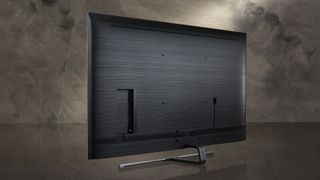
Sound
While the TV has downward facing speakers, its performance is surprisingly robust, there's enough volume for typical living room living and the wider cabinet that accommodates the FALD backlight allows for drivers that offer a decent mid- and upper range performance.
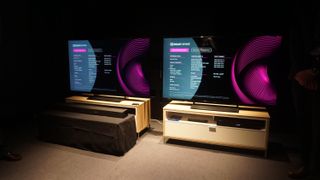
Other panels to ponder...
There’s no shortage of rivals to the Q80R. Most tempting is arguably the Panasonic GX800 LED-LCD range. Another 4K HDR offering, the GX800 combines superb image processing with a wide colour gamut panel, and, it’s HDR support covers all the bases, from HDR10 through to HDR10+ and Dolby Vision.
Alternatively, consider the 65-inch Sony KD-65XG8505 (XBR-65X850G in the US), which offers both the brand’s outstanding X1 image processor and highly effective Acoustic Multi-Audio sound system. It also offers Dolby Vision HDR, but not HDR10+.
Verdict
The Samsung Q80R is a quality QLED. It comes close to the extreme HDR performance of the range-topping Q90R, offering pictures with inky blacks, vibrant colour fidelity and outstanding clean detail. We also like the accommodating nature of the Tizen smart platform.
The only caveats are price, which is invariably on the steep side, and a certain elephant in the room named Dolby Vision.
- Don't miss our round-up of the best TVs
- Get the best deal on Samsung products with our Samsung promo codes.
Steve has been writing about AV and home cinema since the dawn of time, or more accurately, since the glory days of VHS and Betamax. He has strong opinions on the latest TV technology, Hi-Fi and Blu-ray/media players, and likes nothing better than to crank up his ludicrously powerful home theatre system to binge-watch TV shows.
